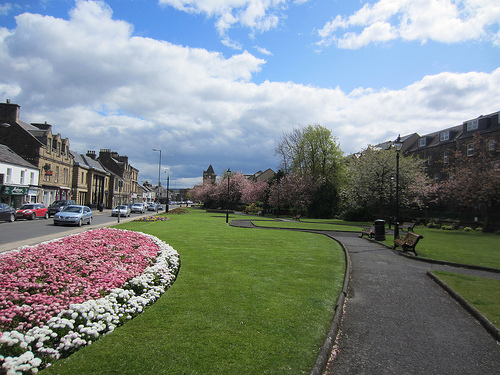Galashiels
The Scottish border town of Galashiels is situated in a small valley, close to where Gala Water meets the River Tweed. This is very much the heart of the border country and like many of the settlements here Galashiels grew up around the textile industry, reaching its population and prosperity peak in the nineteenth century. Though there is very little of the active textile industry left, visitors cannot fail to see the marks left on the town by what was once the life blood of the region.

One of the most striking aspects of the Galashiels is its war memorial. The memorial takes the form of a Border Reiver Horseman and is a striking piece of work by a local sculptor by the name of Thomas Clapperton. The local Lairds made their home at Gala House for many a century and this impressive building is now a museum and gallery which is surrounded by beautifully landscaped gardens. Many of the Lairds themselves were interred upon Gala Aisle as far back as the seventh century, a site which has recently been restored to its former glory.
Places to Visit
Within the walls of Gala House you will find a full five centuries of local history. You will learn about the people that once lived there and how the town of Galashiels was developed right from its earliest beginnings. You will also find that there is a facility which allows you to research your family genealogy within the museum too, as well as a number of different children’s activities, gift shops and tea rooms. The Bank Street Gardens were created by the local council just after the close of the Second World War. They were designed to bring colour and life back to the town, and are known locally for their wonderful displays of colour, especially during the spring when the cherry trees are heavy with blossom. The gardens make the perfect place for an afternoon picnic.
Things to See and Do
Melrose Abbey is a popular visitor attraction; it has a very informative and interesting visitors centre which is located close by. Whatever you may expect, the museum within the visitor centre is sure to surprise you, just as the ruins of the abbey itself will. Make a point of looking at the incredibly detailed work of the stonemasons and see if you can find the bagpipe playing pig. The abbey is also believed to be the final resting place of the heart of Robert the Bruce.
A visit to the Three Hills Roman Heritage Centre will enlighten you to exactly what it was that the Romans ‘did for us’. From the way that they revolutionised the way that our roads were built to the introduction of their justice system. The centre is filled with artefacts and relics which relate to the Trimontium Fort which was home to a Roman garrison during the first and second centuries. All of the items on show have been recovered from the site during the past one hundred years.


